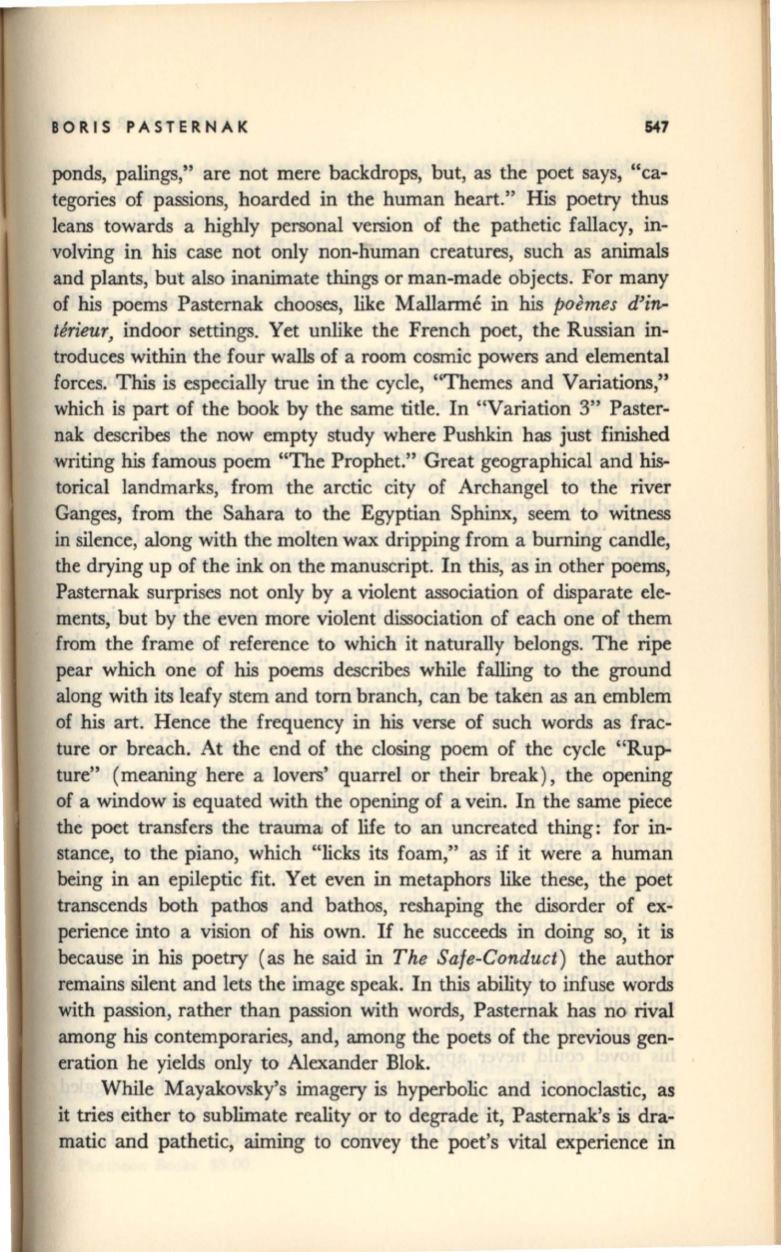
BORIS PASTERNAK
547
ponds, palings," are not mere backdrops, but, as the poet says, "ca–
tegories of passions, hoarded in the human heart." His poetry thus
leans towards a highly personal version of the pathetic fallacy, in–
volving in his case not only non-human creatures, such as animals
and plants, but also inanimate things or man-made objects. For many
of his poems Pasternak chooses, like Mallarme in his
poemes
d'i~
terieur,
indoor settings. Yet unlike the French poet, the Russian in–
troduces within the four walls of a room cosmic powers and elemental
forces. This is especially true in the cycle, "Themes and Variations,"
which is part of the book by the same title. In "Variation 3" Paster–
nak describes the now empty study where Pushkin has just finished
writing
his
famous poem "The Prophet." Great geographical and
his–
torical landmarks, from the arctic city of Archangel to the river
Ganges, from the Sahara to the Egyptian Sphinx, seem to witness
in silence, along with the molten wax dripping from a burning candle,
the drying up of the ink on the manuscript. In this, as in other poems,
Pasternak surprises not only by a violent association of disparate ele–
ments, but by the even more violent dissociation of each one of them
from the frame of reference to which it naturally belongs. The ripe
pear which one of
his
poems describes while falling to the ground
along with its leafy stem and tom branch, can be taken as an emblem
of
his
art. Hence the frequency in
his
verse of such words as frac–
ture or breach. At the end of the closing poem of the cycle "Rup–
ture" (meaning here a lovers' quarrel or their break), the opening
of a window is equated with the opening of a vein. In the same piece
the
poet transfers the trauma of life to an uncreated thing: for in–
stance, to the piano, which "licks its foam," as if it were a human
being in an epileptic fit. Yet even in metaphors like these, the poet
transcends both pathos and bathos, reshaping the disorder of ex–
perience into a vision of his own.
If
he succeeds in doing so, it is
because in his poetry (as he said in
The
Safe-Conduct)
the author
remains silent and lets the image speak. In this ability to infuse words
with passion, rather than passion with words, Pasternak has no rival
among his contemporaries, and, among the poets of the previous gen–
eration he yields only to Alexander Blok.
While Mayakovsky's imagery
is
hyperbolic and iconoclastic, as
it tries either to sublimate reality or to degrade it, Pasternak's is dra–
matic and pathetic, aiming to convey the poet's vital experience in


